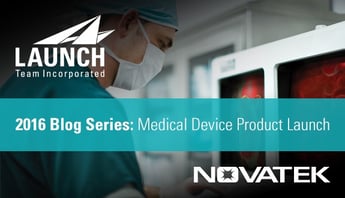
 In our annual deep-dive into the medical device industry, Launch Team collaborates with Novatek, which provides documentation and training services to companies in medical device and other regulated industries. Today’s post explores telemedicine’s implications on customer and user engagement as well as marketing, sales and support.
In our annual deep-dive into the medical device industry, Launch Team collaborates with Novatek, which provides documentation and training services to companies in medical device and other regulated industries. Today’s post explores telemedicine’s implications on customer and user engagement as well as marketing, sales and support.
The Growth of Mobile Medicine
Telemedicine is perhaps the biggest driver of growth in medical devices today, anticipated to jump from 350,000 patients treated in 2013 to 7 million in 2017. By the end of 2016, 20 million insured patients will be able to use smartphones for consults. 70% of doctor visits can be handled over the phone. This represents an opportunity to drive out an anticipated $6B a year in employer healthcare costs, but there are ramifications to both the end users and medical device companies.
Telemedicine offers patients:
- improved access and convenience
- less waiting room time
- cost efficiencies
- privacy
- faster second opinions and access to specialists
Many physicians view telemedicine with promise due to its ability to increase patient compliance and enable more frequent checkups and reminders. However, not everyone is on board with the idea yet.
Two barriers to adoption are:
- Physicians’ discomfort with the technology
- Fear of inadequate assessment
Mobile diagnostic tools and imaging software improvements will help solve the hardware and software issues—but what about engagement? How do you ensure trust and quality of the experience in a remote setting?
Case Study: Bringing a Clinical Model to the Web
When we met the CEO of one personalized “cosmeceutical” company, he had had great success with a clinic-based model in Europe, but he wanted to move to web-based sales and service model in the U.S. due to the impracticality of asking clients to make the trip to clinics spread across the U.S.
The company’s personalized product required daily application, and compliance drove results. A clinic-based assessment established credibility and trust, ensuring close rates and compliance rates over 80%.
How did they recreate the feel and intimacy of this in-person consultation via the web?
- Inbound marketing: They established thought leadership by creating extensive educational materials.
- Marketing automation: They offered an assessment before, after, and throughout treatment; sent personalized and automated messages that specifically addressed what clients may be experiencing at each stage of their program.
- Multi-channel communications: They communicated reminders and check-ins the way that was most convenient for the client—via text, email, phone, or FaceTime. They also offered marketing and customer support content in video, blog, and other media.
- Training: The company provided extensive training to customer support staff to ensure proper image capture, thorough assessment, consistent diagnostic questions, comfort with technology, etc.
- Branding: They paid attention to aesthetics. In an in-office visit, the patient assesses credibility from degrees on the wall, furnishings, etc. He or she will do the same on a video call, just in a smaller field of view. Here are some good tips for looking polished in video chats.
- Call to action: In an office visit, there’s a clear next step and sense of urgency. This company had to be strategic in defining and communicating next steps. They made good use of marketing automation to improve follow-up close rates after initial assessment.
- Authority / credibility: To establish their expertise and grow organic traffic quickly, they used sponsored social media to promote educational blog posts and articles, supplemented by video. By leveraging educational content across platforms, they were able to target specific demographics with information important to them.
- Layered support: Personalized sales and support across time zones challenged this fast-growing team. They used a blend of chat, email, and phone support, all recorded in their CRM. HIPAA compliance was a concern, so careful selection of tools and training was key.
Though the U.S. launch of this company was challenging in many ways, they realized 410% growth in 6 months utilizing this integrated and inbound marketing strategy.
The medical device customer base is ready for telemedicine, but it requires strategic change in the approach to marketing and delivery.
Check back in two weeks for the story of another company, whose remote diagnostic instrument was driven by the move to telemedicine in Europe.
For more ways to improve engagement, download our 10 Tips for Connecting with Medical Device Customers.

